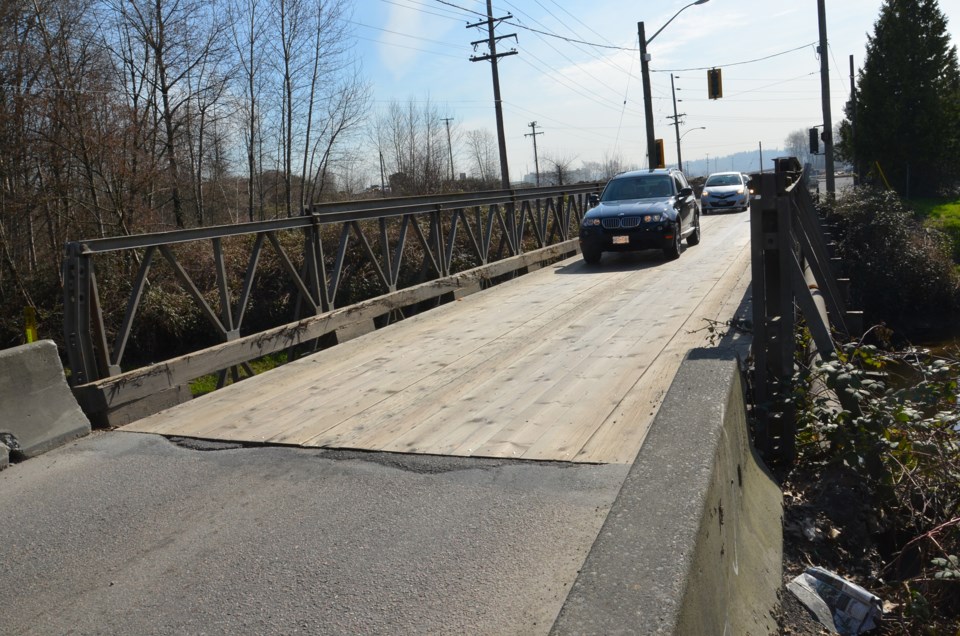The Ministry of Transportation has agreed to lend the City of New Westminster a temporary replacement for the Bailey Bridge – but only if the city installs a second lane at the site to allow for “crucial” two-way traffic flow.
While Coquitlam has been pressing for a two-lane crossing at the location of the current Bailey bridge, New Westminster wants it limited to one lane because of gridlock in the Brunette and Braid area. The matter will be considered by an arbitrator.
Transportation Minister Todd Stone has informed the city that ministry staff have reviewed the site and determined it’s possible to install a second single-lane temporary bridge at this location. He said this would represent a significant interim safety and mobility improvement for drivers in the area until a more permanent crossing is implemented.
Stone told The Record the ministry has two bailey bridges in its inventory and it’s willing to lend them to the City of New Westminster for an indefinite period of time. He said he’s not prepared to participate in a one-lane temporary solution.
“When we looked at this, at the end of the day the decision was mine,” he said. “The conclusion I came to in terms of what is in the best interests of the health and safety of people who live in the region, I am mostly referring to the ability of people to get to Royal Columbian in a timely fashion, coupled with how important that corridor is from a commuter’s perspective and a goods movement perspective – the province is just not willing to participate in a plan that involves replacing a one-lane bailey bridge with a one lane bailey bridge.”
Stone said the province is putting a proposal on the table that’s a “tremendously good deal” for the people of New Westminster as it’s putting $2 million in value on the table for two temporary bridges. He said New Westminster won’t have to pay any costs related to the second crossing, as Coquitlam has offered to contribute up to $800,000 towards those costs.
“We believe that the appropriate solution for this corridor is a two-lane bridge. The arbitration will determine whether the long-term solution is to be one lane or two lanes. That arbitration process will continue,” he said. “New West doesn’t have to accept our offer here. If they don’t then they can proceed accordingly with an alternative solution, which would be the acquisition of a bailey bridge from some other source, at a cost to the taxpayer, and they can explain to their taxpayers why they are saying no to $2 million worth of infrastructure, albeit from a temporary perspective while the arbitration continues.”
Lois-Leah Goodwin has been appointed as the arbitrator who will be ruling on the matter of whether a two- or multi-lane crossing is appropriate for the site.
“The arbitration process will continue. The arbitration process may take a considerable amount of time – three, six, nine months. There are a number of different steps in the arbitration process. …It’s not entirely clear how long that arbitration process will continue,” Stone said. “Again, it’s totally up to New West. Nobody is forcing this on them. My job is to ensure the safe movement of people and goods through our transportation corridors in the province. When I look at traffic analysis on this corridor, this corridor should have had a two-lane bridge installed years ago. Remember it was the City of New Westminster, which turned its back on over $60 million in federal funding for a proper two-lane bridge to be installed.”
Stone believes anyone who looks at this with common sense in mind will see that having two lanes on either side of the crossing lead to a one-lane alternating bridge “makes no sense” and is going to cause a bottleneck. He doesn’t believe that putting two lanes in the area will increase traffic in the Braid and Brunette area.
“At the end of the day New Westminster is in the heart of the Lower Mainland with a critical transportation hub,” he said. “You have one of the most important regional hospitals in the City of New Westminster that the people of the region need to have confidence they can safely and quickly get to. From the safety of movement of people and goods, this corridor more than warrants a two-lane bridge to manage the volume of traffic that is already moving through it.”
Mayor Wayne Wright said it’s “more than a red herring” to suggest that two lanes are needed so people can safely access Royal Columbian Hospital. He said the city has been firm in its support for a one-lane crossing because the bridge leads to the congested Brunette and Braid area and a busy railway corridor.
Wright was surprised to learn the province would only lend the city a temporary bridge if it agreed to a second crossing, as that was “never” something the province had proposed as a condition in the past. While the minister supports a two-lane crossing through the area, he hopes the city will be able to get a “good hearing” and have an arbitrator who is willing to listen to the facts and consider engineering and safety in the area.
The existing bridge has been closed to vehicle traffic since the beginning of March because of concerns about its structural integrity. Associated Engineering inspected the bridge and expressed concerns that further repairs to the structure could result in the growth or formation of cracks at other locations, which it may not be able to identify or inspect before failure takes place.
Wright disagrees that traffic won’t increase in the area if two crossings are provided. He said one study projected a 50 per cent increase in traffic if a two-lane crossing went through the area.
Wright said staff and city council will need to consider the province’s offer.



